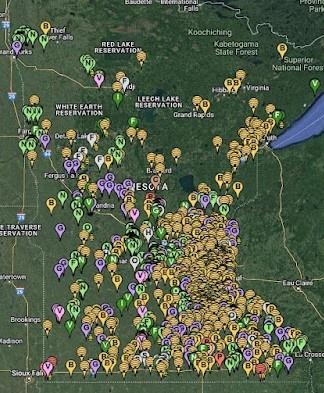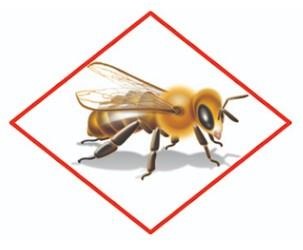By Tana Haugen-Brown and Lizabeth Stahl et.al
Off-target movement of pesticides is a concern for crop growers and their neighbors. For example, herbicide drift can damage adjacent crops and ornamental plants. When pesticide treatments are needed on crop fields, it is important to be aware of sensitive sites in the area. This has become an even greater concern with increased use of growth regulator (Group 4) herbicides which can cause plant injury at extremely low rates. Newer 2,4-D and dicamba product labels specify that surrounding areas should be surveyed for the presence of sensitive species prior to application. In addition, many other frequently used herbicides, such as glyphosate (Group 9), PPO-inhibitors (Group 14), and HPPD inhibitors (Group 27) have numerous label precautions to avoid drift onto sensitive plants. Use the FieldWatch map resource, https://mn.driftwatch.org/map, to help find the locations of sensitive crops in the area.

FieldWatch map for Minnesota.
In addition to herbicide concerns, insecticide drift to beehives and flowering plants that are attractive to foraging bees can result in reduced bee vigor and bee-kills. If crop scouting indicates that an insecticide treatment is needed based on integrated pest management economic thresholds, it is important to protect beehives near the application area. Prior to making an insecticide spray, check the label for information regarding toxicity to bees. If pollinator toxicity is a concern, the product label often carries a bee hazard icon and includes instructions for minimizing harm to bees.

Another important step is to provide advance notification of an intended insecticide application to beekeepers with hives within 2-3 miles of the field to be sprayed. Beekeepers can also be found by checking the FieldWatch map.
FieldWatch is a Google Map based system and is easy to use. You can find your area of interest by manually searching the map or by entering an address or latitude/longitude in the search bar. Selecting a pin on the map brings up contact information for the producer at that site. Pesticide applicators can inform beekeepers about a planned insecticide application in their area to allow them time to move, cover, or screen their hives. It is recommended to provide notifications at least 48 hours prior to application.
Some beekeepers choose to not display their hives on this map if theft or vandalism is a concern. However, these hive locations are displayed for applicators registered with FieldCheck. This service is free. Signup at: https://driftwatch.org/signup#applicator. Links to information and videos about using this service is available at www.mda.state.mn.us/plants-insects/fieldwatch-driftwatch-beecheck-fieldcheck.
Neighboring States. For applicators who also operate in neighboring states, FieldWatch is available in most of these states. However, North Dakota uses a different system for mapping pesticide sensitive sites. Applicators who operate in North Dakota should also become familiar with the North Dakota Bee Map.
Source : umn.edu